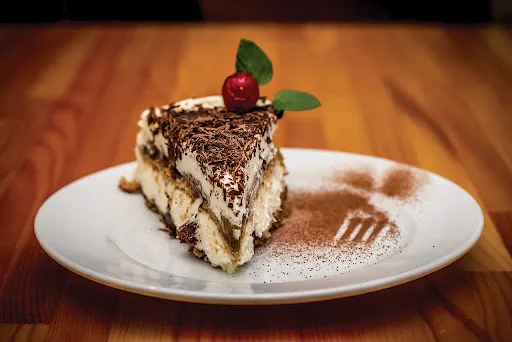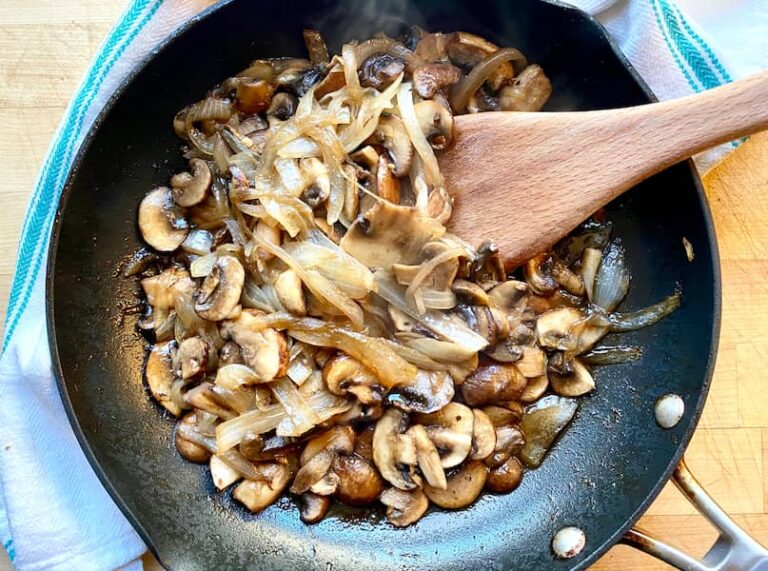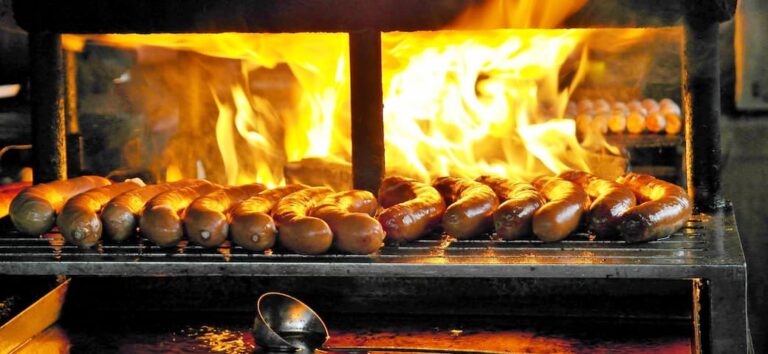Renowned as a beloved classic Italian dessert, tiramisu has graced the menus of authentic Italian restaurants for decades, captivating diners with its delicate layers of espresso-dipped ladyfingers and creamy mascarpone. However, for those with dietary restrictions, the temptation of enjoying a traditional tiramisu can be accompanied by a sense of apprehension.
If that’s your case, this post is for you! With our irresistible gluten-free tiramisu recipe, you can savor every moment of this delicious dessert without worrying.
After making the gluten-free cookies I wrote about a couple weeks ago, I wanted to explore new possibilities with them. So, I used the same recipe to make some ladyfinger biscuits and embarked on a new culinary experiment.
The result? A delightful twist on classic tiramisu that is gluten-free and has extra amounts of chocolate!
My family loved it, and I’m sure you will, too!
What you’ll need
With the previous info in mind, let’s start writing down our shopping list. These key ingredients will form the foundation of your gluten-free tiramisu.

Raw egg yolks: many modern tiramisu recipes (including some that I’ve posted here) are made with both egg yolks and whites. However, tiramisu was originally made with just egg yolks. This method is much easier and faster, and I thought it matched perfectly with the simplicity of this gluten-free recipe.
With their velvety texture and binding properties, egg yolks play a crucial role in creating the creamy richness of the mascarpone cream. It is important to note that we are using uncooked eggs in this recipe, so it’s essential to ensure the eggs are fresh and handled properly.
Mascarpone cheese: the creaminess of the mascarpone, combined with the coffee-infused ladyfingers, forms the heart of this irresistible dessert. This Italian cream cheese is easily found in most grocery stores.
Like raw egg yolks, it is one of the ingredients featured in the oldest tiramisu recipes, instead of modern alternatives like heavy cream or whipping cream. I find it better than the others for its unique flavor and consistency.
Gluten-free ladyfinger biscuits: or savoiardi, as they are called in Italy. They will provide a light and delicate base for our tiramisu and ensure that every bite is a delightful balance of texture and flavor. They’re traditionally made with wheat flour, but nowadays it’s very easy to find gluten-free alternatives made with rice flour, coconut flour, or almond flour.
Pro-tip for chocolate lovers: If you can’t find gluten-free ladyfingers at your local store, or simply want to try out more options, switch them with my chocolate chip gluten-free cookies. I tried making tiramisu with them a couple of times and it tasted delicious! The texture provided by the cookies and the occasional crunchiness of the chocolate chips were a perfect addition.
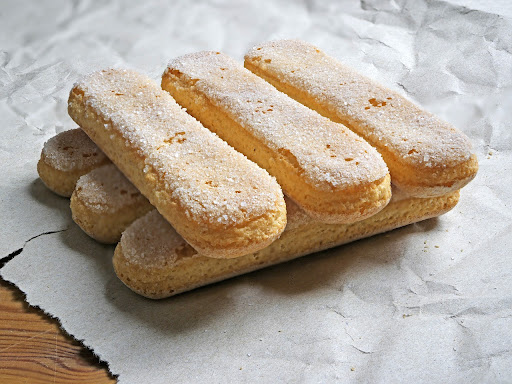
Espresso: dip each biscuit into freshly brewed espresso, allowing it to absorb the aromatic coffee flavor. This step adds a delightful depth to the overall taste experience of our gluten-free tiramisu.
Unsweetened cocoa powder and gluten-free chocolate shavings: to add a finishing touch. It will enhance the visual appeal and add a hint of bitterness to counterbalance the sweetness.
The raw egg yolks, rich mascarpone cream, espresso-dipped ladyfingers, and a dusting of cocoa powder and chocolate shavings come together to create a dessert that is delicious, healthy, and gluten-free. Now, let’s see how to make it anytime you want!
How to make gluten-free tiramisu – step by step
Let’s start by preparing the egg yolk mixture for your gluten-free tiramisu.
Beat the egg yolks in a bowl with a hand whisk, gradually incorporating the sugar. Add the mascarpone cheese to the egg yolk mixture and mix thoroughly until the cheese is fully incorporated. Then, leave the mixture in the fridge for 30 minutes. This will give it the right consistency, and allow the flavors to meld.
Next step, prepare the espresso-dipped ladyfingers. Pour the espresso onto a plate, and place a small plumcake stamp on a tabletop. Dip the gluten-free ladyfingers into the coffee individually, ensuring they are fully coated, and arrange them in a single layer on the bottom of the stamp.
Now, it’s time to create the layers of the tiramisu. Spread half of the mascarpone mixture evenly over the ladyfingers, ensuring it covers the surface completely. Repeat the process to create a second layer of ladyfingers followed by another layer of the mascarpone mixture. Use a spatula to smooth and even out the final layer.
To add a finishing touch, sift unsweetened cocoa powder generously over the top of the tiramisu, and add the gluten-free chocolate shavings.

Cover the baking dish with plastic wrap and refrigerate for at least five hours, in order to allow the flavors to meld and the tiramisu to set.
Just before serving, take the tiramisu out of the fridge and remove the plastic wrap. Slice it into individual portions, and enjoy!
How to pasteurize the eggs
If you don’t feel safe using raw eggs, you can pasteurize them using simple syrup instead of sugar.
This precautionary measure is not strictly necessary as long as you use high-quality, fresh eggs, and to be honest, I have never used it. However, I find it fair to provide all the necessary info when it comes to food safety, so here’s what you need to do:
- Melt the sugar in a saucepan with a tablespoon of water and bring it to a temperature of 250°F.
- Meanwhile, start whipping the egg yolks until they are well beaten, about 3-4 minutes.
- Gradually add the melted sugar to the whipped yolks, continuing to whip.
- Initially, the cream will lose volume and become runnier, but don’t worry. As it cools, it will gain consistency and become creamy again.
- Keep whipping until the mixture has cooled completely and the sugar has been incorporated.
At this point, the whipped yolks are pasteurized and can be mixed with the mascarpone to complete the tiramisu.
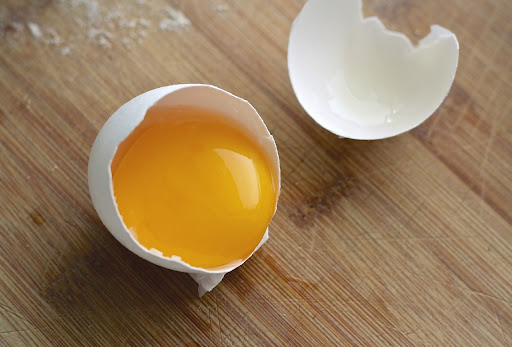
How to store your gluten-free tiramisu
The easiest way to store tiramisu is to keep it in the refrigerator into an airtight container and consume it within 1-2 days.
Keep in mind that it’s a dessert made with raw eggs, so it can go bad quickly.
If (and only if) you’ve used pasteurized eggs, you can also freeze it within the first 24 hours and store it in the freezer for several weeks. Some say even up to 3 months. But to be honest, I see no reason to do it. It tastes so good when eaten fresh!
If you decide to try this way, make sure to freeze your tiramisu in small portions, as it can’t be re-freezed and will have to be consumed within 12 hours after defrosting.
Tips and tricks
Now, let’s look at some tricks to make sure your gluten-free tiramisu is always a success. Here’s everything you need to know.
1) When it comes to tiramisu, one of the most common Google searches is, “How to prevent your tiramisu from getting soggy?”
If you’re wondering this too, well, the secret is all in the espresso. Many people use hot coffee as soon as it is brewed, or they soak their ladyfinger biscuits too long. In either case, this can cause the cookies to break or become soft, ruining the texture of the dessert.
To avoid this, wait for the coffee to cool a little before using it, and gently coat the cookies on both sides without soaking them for too long.
2) Choose Bitter Cocoa: when sprinkling cocoa powder over tiramisu, it is best to avoid the sweetened varieties. Using bitter cocoa not only improves the visual appearance of the dessert, but also helps balance the sweetness of the other ingredients. This provides a harmonious flavor profile without making the tiramisu overly sweet.
3) Patience is Virtue: although it is tempting to taste your creation immediately, it is critical to allow the flavors to blend properly. Place your tiramisu in the refrigerator for 2 to 5 hours. This resting period allows the various layers to solidify and the flavors to develop, resulting in a harmonious and perfectly blended dessert. Trust me, the wait will be worth it!
4) Make sure the Mascarpone is at Room Temperature: this will make it easier to soften and incorporate with the egg yolks, resulting in a smooth and creamy texture.
By following these proven tips, you will be on your way to creating a perfect gluten-free tiramisu that will delight your palate and amaze your guests. Enjoy the process and savor every bite!
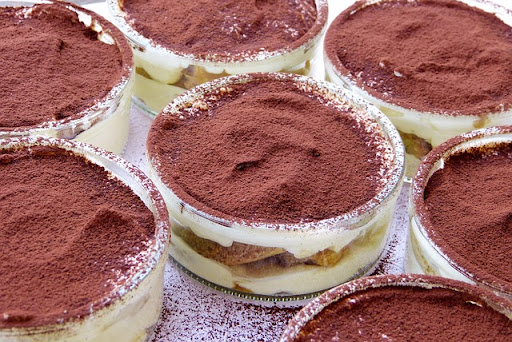
Gluten-free tiramisu FAQs
1. Does gluten-free tiramisu have dairy?
This specific recipe does (it’s in the mascarpone). However, if you can’t have dairy, you can easily solve the problem by using vegan cream cheese.
2. Can gluten-free tiramisu be made without alcohol?
Yes, of course. Many modern versions of tiramisu are made with marsala wine or coffee liqueur, but the original tiramisu recipe doesn’t actually contain alcohol, and this gluten-free version doesn’t either.
3. What is mascarpone cheese?
Mascarpone is an Italian cream cheese similar to heavy cream, that has gained popularity worldwide for its rich yet delicate taste and velvety texture.
It is a very versatile cheese that can be used in both sweet and savory dishes.
In desserts, mascarpone is often used to create creamy fillings, frostings, and toppings. It is also a popular addition to many pasta sauces, providing extra smoothness and flavors.
4. Can you make tiramisu without mascarpone?
Mascarpone contributes to the rich and creamy texture that is characteristic of tiramisu. To be honest, I wouldn’t change it with other substitutes. However, if you don’t have it at home or prefer to avoid it for dietary reasons, there are some alternatives available.
The first option that comes to mind is heavy cream. Alternatively, another popular substitute is a combination of cream cheese and whipped cream, which can provide a similar creamy consistency. I have also seen people using a 50/50 mixture of mascarpone and ricotta to make a lighter tiramisu, but I have never tried it so I don’t know what it tastes like.
Keep in mind that the flavor and texture may vary slightly from the traditional version, but it can still result in a delicious dessert. Experiment with different substitutions and ratios to find a combination that suits your preferences!
5. Can you make tiramisu without coffee?
Coffee is one of the key ingredients for traditional tiramisu. Like for mascarpone, I wouldn’t normally use alternatives, unless I’m planning to make a totally different version of this dessert, like limoncello tiramisu. In all the other cases, I would recommend using decaffeinated coffee or coffee liqueur as a substitute.
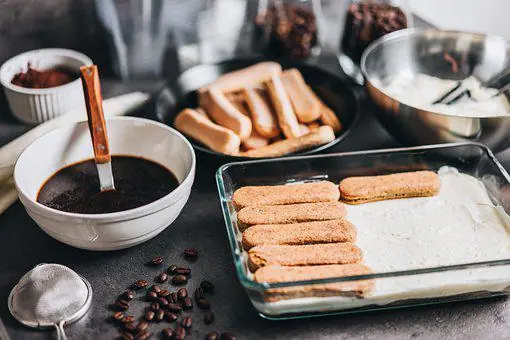
6. What can I make with the leftover egg whites?
My favorite way of using leftover egg whites is making meringues. Here are some quick instructions if you want to try it out:
- add 3 oz of egg whites to a standover mixer, and start whipping at low speed;
- as their volume increases, turn the speed to medium, then high. In the meantime, gradually add 6 oz of powdered sugar;
- when the egg whites start forming stiff peaks on the whisk attachment, transfer them into a sac à poche;
- cover a baking sheet with greaseproof paper, and use the sac à poche to shape your meringues.
- bake in a preheated oven at 170° F for 1 hour and 20 minutes;
- turn off the oven and open its door, but leave the meringues inside for another couple of hours, then enjoy them as you like.
You can also use your leftover egg whites to make macarons or angel food cake.

7. Where can I buy gluten-free lady fingers?
Gluten-free ladyfinger cookies are now sold in many grocery stores and, of course, online. However, I really recommend you try to make them at home with the recipe I linked earlier in the “What you’ll need” section. They will taste better than store-bought alternatives, and you’ll learn how to make them anytime you want.
Conclusion
That’s all, at last.
I know, this was a very long post, but now you really know all you need to start making your own gluten-free tiramisu and improve your dessert game!
If you try this recipe, let me know what you think of it and leave a review.
As per usual, here’s the recipe card with the precise ingredients and all the instructions. Have fun!
Print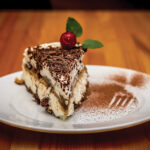
Easy Gluten-Free Tiramisu Recipe
5 Stars 4 Stars 3 Stars 2 Stars 1 Star
No reviews
- Author: Mortadella Head
- Total Time: 345 Minutes
- Yield: 1 1x
- Diet: Gluten Free
Description
Indulge your dessert cravings with this easy gluten-free tiramisu recipe and elevate your dessert game. This twist on a classic Italian favorite is a captivating symphony of rich chocolate, velvety mascarpone, and delicate espresso-infused ladyfingers. Each bite will leave you longing for more, as you savor the harmonious blend of flavors in this irresistible gluten-free delight.
Ingredients
16 gluten-free ladyfingers
5 fresh egg yolks
2 cups of mascarpone cheese
7 tbsp sugar
1 cup espresso coffee
unsweetened cocoa powder to taste
Instructions
Making the cream:
- In a bowl, beat the egg yolks with a hand whisk, gradually adding the sugar until well combined.
- Add the mascarpone cheese to the egg yolks and mix well until fully incorporated.
- Place the mixture in the fridge for 30 minutes to chill and allow the flavors to meld.
- Pour the espresso onto a plate, and put aside a plumcake stamp on a tabletop.
- Dip the gluten-free ladyfingers into the coffee one by one, and arrange them in a single layer on the bottom of the dish.
- Spread half of the cream evenly over the ladyfingers.
- Create a second layer of cookies and cream. Use a spatula to make sure that the final layer is as even as possible.
- Sift the unsweetened cocoa powder generously over the top.
- Cover the baking dish with plastic wrap and refrigerate for at least five hours to allow the flavors to meld and the tiramisu to set.
- Just before serving, take out of the fridge, remove the plastic wrap, slice, and enjoy!
Notes
Disclaimer: The nutritional information provided for this recipe is only an estimate generated with VeryWellFit’s online calculator. The accuracy of the facts listed is not and cannot be guaranteed.
- Prep Time: 45 Minutes
- Coolling Time: 300 Minutes
- Category: Dessert
- Method: Refrigerated
- Cuisine: Italian
Nutrition
- Serving Size: a 1-inch thick slice
- Calories: 476
- Sugar: 45.2g
- Sodium: 158mg
- Fat: 14.9g
- Saturated Fat: 8.2g
- Carbohydrates: 73.3g
- Fiber: 0g
- Protein: 12.7g
- Cholesterol: 253mg

